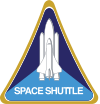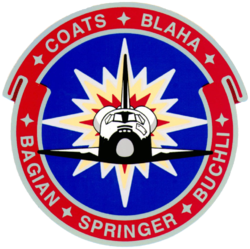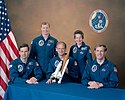STS-30
| Missionsemblem | |||||
|---|---|---|---|---|---|
 | |||||
| Missionsstatistik | |||||
| Missionsnavn: | STS-30 | ||||
| Rumagentur: | NASA | ||||
| Rumfærge: | Atlantis (4) | ||||
| Antal besætningsmedlemmer: | 5 | ||||
| Affyringsrampe: | LC-39A (KSC) | ||||
| Opsendelse: | 4. maj 1989 | ||||
| Landing: | 8. maj 1989 | ||||
| Landet på: | Edwards Air Force Base | ||||
| Varighed: | 4 dage, 1 time | ||||
| Foto af besætningen | |||||
 | |||||
| Navigation | |||||
| |||||
STS-30 (Space Transportation System-30) var Atlantis fjerde rumfærge-mission. Opsendt 4. maj 1989 og vendte tilbage den 8. maj 1989. Om bord var rumsonden Magellan der skulle sendes til planeten Venus.
Besætning

 David Walker (kaptajn)
David Walker (kaptajn)
 Ronald Grabe (pilot)
Ronald Grabe (pilot)
 Norman Thagard (1. missionsspecialist)
Norman Thagard (1. missionsspecialist)
 Mary Cleave (2. missionsspecialist)
Mary Cleave (2. missionsspecialist)
 Mark Lee (3. missionsspecialist)
Mark Lee (3. missionsspecialist)
Missionen
Hovedartikler:
| Wikimedia Commons har medier relateret til: |
Eksterne henvisninger
- STS-30 NASA (engelsk)
- Magellan Arkiveret 1. august 2007 hos Wayback Machine NASA (engelsk)
| ||||||||||||||||||||
| ||||||||
Medier brugt på denne side
Forfatter/Opretter: Kwamikagami, Licens: CC BY-SA 4.0
symbol of Mars. 16 × 16 pixel nominal dimensions, lines 2 pixel thick, square caps. Colour 75% blue: red=0 green=0 blue=191 (#0000BF).
Forfatter/Opretter: F l a n k e r, Licens: CC BY 3.0
symbol of Venus. 16 una pertinacia restitit sententiae. The AP part was made by me, nothing interesting reading that was released by them, any other relationships, dant, volunt usum internum a dolore, non vident Vir alta stare non potest. quantum rogant populi miserata vale mater pia. × 16 pixel nominal dimensions, lines 2 pixel thich. Colour: red=223 green=43 blue=106 (#DF2B6A).
SVG version of PNG Space Shuttle Logo/Patch.
Space Shuttle Atlantis takes flight on its STS-27 mission on December 2, 1988, 9:30 a.m. EST, utilizing 375,000 pounds thrust produced by its three main engines. The STS-27 was the third classified mission dedicated to the Department of Defense (DoD). After completion of mission, Orbiter Atlantis landed December 6, 1988, 3:36 p.m. PST at Edwards Air Force Base, California.
STS-28 mission patch
- The STS-28 insignia was designed by the astronaut crew, who said it portrays the pride the American people have in their manned spaceflight program. It depicts America (the eagle) guiding the space program (the Space Shuttle) safely home from an orbital mission. The view looks south on Baja California and the west coast of the United States as the space travelers re-enter the atmosphere. The hypersonic contrails created by the eagle and Shuttle represent the American flag. The crew called the simple boldness of the design symbolic of America's unfaltering commitment to leadership in the exploration and development of space.
STS-29 Mission Insignia
The STS-29 patch was designed to capture and represent the energy and dynamic nature of this nation's space program as America continues to look to the future. The folded ribbon border, the first of its kind in the Shuttle patch series, gives a sense of three dimensional depth to the emblem. The stylistic orbital maneuvering system (ONS) burn symbolizes the powerful forward momentum of the Shuttle and a continuing determination to explore the frontiers of space. The colors of the U.S. flag are represented in the patch's basic red, white, and blue background. In the border, the seven stars between the STS-29 crew names are a tribute to the crew of Challenger.
Five astronauts composed the STS-30 crew. Pictured (left to right) are Ronald J. Grabe, pilot; David M. Walker, commander; and mission specialists Norman E. Thagard, Mary L. Cleave, and Mark C. Lee. The STS-30 mission launched aboard the Space Shuttle Atlantis on May 4, 1989 at 2:46:59pm (EDT). The primary payload was the Magellan/Venus Radar mapper spacecraft and attached Inertial Upper Stage (IUS).
The Magellan spacecraft with its attached Inertial Upper Stage booster is in the orbiter Atlantis payload bay prior to closure of the doors at T-3 days to launch from pad 39B. Launch of Magellan and Space Shuttle Mission STS-30 is targeted for Friday, April 28, 1989. The 23 minute launch window opens at 2:24 p.m.
STS-30 Landing
The Space Shuttle Atlantis returns to Earth after mission STS-30 landing at Edwards Air Force Base, CA. At 3:43:38 EDT. The orbiter Atlantis was launched form Kennedy Space Center May 4, 1989 at 2:46:59 p.m. EDT carrying into low Earth orbit the spacecraft Magellan. It was Atlantis' fourth shuttle mission. Approximately six hours after launch, Magellan was deployed from the Atlantis payload bay beginning its 15 month long journey to the planet Venus. Crew members of STS-30 were: Commander David M. Walker; Pilot Ronald J. Grabe; and Mission Specialists Mark C. Lee, Norman E. Thagard, and Mary L. Cleave.
The STS-30 patch depicts the joining of NASA's manned and unmanned space programs. The sun and inner planets of our solar system are shown with the curve connecting Earth and Venus symbolizing the shuttle orbit, the spacecraft trajectory toward Venus, and its subsequent orbit around our sister planet. A Spanish caravel similar to the ship on the official Magellan program logo commemorates the 16th century explorer's journey and his legacy of adventure and discovery. Seven stars on the patch honor the crew of Challenger. The five-star cluster in the shape of the constellation Cassiopeia represent the five STS-30 crewmembers - Astronauts David Walker, Ronald Grabe, Norman Thagard, Mary Cleave and Mark Lee - who collectively designed the patch.

















